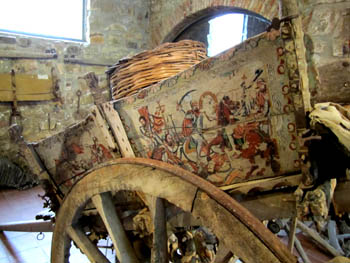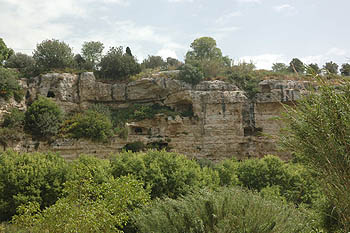
 (Click on any picture for a larger version)
(Click on any picture for a larger version)
SICILY ! or ?
Why did we choose Sicily as our destination for the spring of 2013?
Perhaps it was because we'd never been there. Or because it's part of Italy - a country we love. Or because there's so much said and written about it:
"To have seen Italy without having seen Sicily is not to have seen Italy at all, for Sicily is the clue to everything," wrote Goethe in 1784.
A century later, in the historical fiction novel, The Leopard, Don Fabrizio Corbera, Prince of Salina, says: “In Sicily, it doesn’t matter about doing things well or badly; the sin which we Sicilians never forgive is simply that of ‘doing’ at all.”
And now there lurks a disturbingly dark but intriguing Mafia image of Sicily - the one popularized in 20th century films like The Godfather and still prevalent in current media reporting.
Whatever the reason/s for the choice, ambivalence overshadowed it (and all of our planning) - so much so that we booked return tickets to Rome but only a one-way ticket to Sicily, leaving our return open.
Catania
On Friday (April 26, 2013), we flew Air Transat to Rome and made a quick connection to Al Italia just in time to catch our flight to Catania, the second largest city in Sicily. A long, winding bus ride from the airport through the city, took us to Piazza Stesicoro and from there a walk through narrow, dingy side streets brought us to Hotel Manganelli Palace where we had booked two nights.
Our first impression of Catania was neutral to negative with the buildings looking shabby and dirty - a bit like Old Havana. However, as we discovered the next day, when the sun came out, the city can look and feel much better. It is a mixture of lovely façades 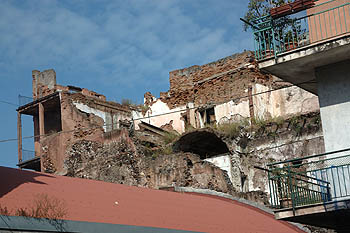 and Italianate style buildings with many still damaged, and some derelict, buildings - casualties of the nearby volcano, earthquakes, and wars. Much of that damage (especially that due to WWII allied bombing) is still not repaired.
and Italianate style buildings with many still damaged, and some derelict, buildings - casualties of the nearby volcano, earthquakes, and wars. Much of that damage (especially that due to WWII allied bombing) is still not repaired.
The hotel, a fancy private Palazzo of the past, we discovered to our pleasure, was lovely with frescoed ceilings and it turned out to be in a great location (although it was hard to find initially.) Our room on the fourth floor was spacious with a tiny balcony that opened onto Via Antonio di Sangiulano, a busy but not noisy street.
 We walked around the historic part of Catania before supper nearby where Tana had Pasta a la Norma, a Catenin "speciality" (which turned out to be the "specialty" in almost every Sicilian town). It's kind of bland - large pasta noodles with eggplant, fresh basil and mild cheese as was the vegetable & poached egg dish she had as her second course. George had pasta of artichokes, peas and mushrooms, followed by grilled sardines. Nothing exciting but OK as a first meal.
We walked around the historic part of Catania before supper nearby where Tana had Pasta a la Norma, a Catenin "speciality" (which turned out to be the "specialty" in almost every Sicilian town). It's kind of bland - large pasta noodles with eggplant, fresh basil and mild cheese as was the vegetable & poached egg dish she had as her second course. George had pasta of artichokes, peas and mushrooms, followed by grilled sardines. Nothing exciting but OK as a first meal.
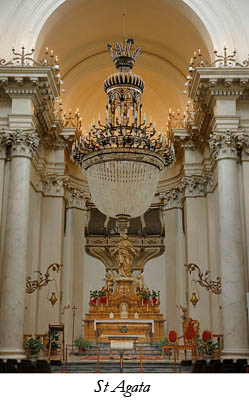 We woke at 8 am on Saturday (after a good sleep) to grey skies and some light rain. But this didn’t stop us from visiting the Church of the Abbey of Saint Agata of Sicily. One of the most highly venerated virgin martyrs of Christian antiquity, Agata was put to death (after her breasts were cut off)during the persecution of Decius (250-253).
We woke at 8 am on Saturday (after a good sleep) to grey skies and some light rain. But this didn’t stop us from visiting the Church of the Abbey of Saint Agata of Sicily. One of the most highly venerated virgin martyrs of Christian antiquity, Agata was put to death (after her breasts were cut off)during the persecution of Decius (250-253).
Switching from the spiritual to the sensual, we explored the fish market for a recommended fish restaurant. But Tana was turned off by the severed heads and bloody bodies of the fresh fish (and meat/animals) so we escaped to the Benedictine Monastery of San Nicolo l’Arena. More like a palace than a 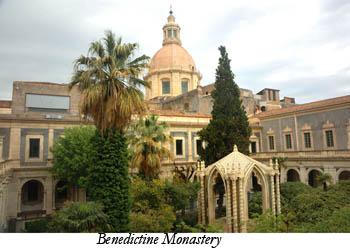 religious building due to its previous close links between the Benedictine monks and the Catania nobility, it is now the Faculty of Literature and Philosophy for the University of Catania.
religious building due to its previous close links between the Benedictine monks and the Catania nobility, it is now the Faculty of Literature and Philosophy for the University of Catania.
The weather had improved so we changed our shoes and dumped our sweaters before lunch at Antiqua Sicilia (T: pizza veg. and G: penne with anchovies, peas, tomatoes and bread crumbs).
Under clear skies and bright sunshine, we walked to the Castel Ursino (circa from 1239 to 1250), the Duomo (or Catholic Cathedral, also dedicated to Saint Agata,) and shops on Via Aetna, before supper at Sicilia in Boca (an excellent meal - T: pasta of fresh pistachios and G: carpaccio of tuna with citrus dressing.)
On Sunday, we woke to sunshine and walked through Piazza Duomo to photograph the symbolic and appealing Elephant fountain, created in 1736 as in imitation of Bernini's Minerva Elephant in Rome; a hint of Catania's long and varied past.
 We planned to catch the# 457 bus to the airport at 11 to get our rental car.
But the bus never came. We gave up waiting at 12:15 and shared a taxi with a young Romanian man (who had been waiting for the same bus). At the airport, I discovered that what Sicilians think of as a lineup is actually a huge crowd shuffling and elbowing. Eventually, after an hour and a half, we got to the car rental desk and had the keys to our oversized diesel car - disturbingly bigger and more awkward than the compact we'd reserved.
We planned to catch the# 457 bus to the airport at 11 to get our rental car.
But the bus never came. We gave up waiting at 12:15 and shared a taxi with a young Romanian man (who had been waiting for the same bus). At the airport, I discovered that what Sicilians think of as a lineup is actually a huge crowd shuffling and elbowing. Eventually, after an hour and a half, we got to the car rental desk and had the keys to our oversized diesel car - disturbingly bigger and more awkward than the compact we'd reserved.
With our goal for the day being Taormina, along the shoreline northwest of Catania, we drove up the coast through cluttered and ugly villages and lots of cars but with no visible sign of beaches. Taormina was well signed but, despite that, hard to find. Finally, after circling the town, we parked at the Port Catania gate in a parking lot hidden in the side of a hill.
Taormina
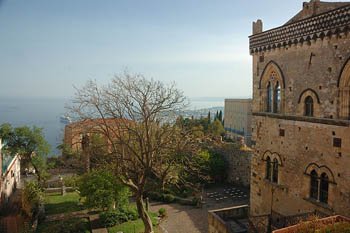
The town held promise; it was lovely but very crowded with cruise ship tourists. After finding a room at the Hotel Del Corso - a lovely room with a small balcony that had a wonderful view of the coast and sea, we set out for a walk about town before dinner. The main street was pleasantly crowded with locals out for their evening 'passagatta' when young, old and everyone in between leave their homes to walk, talk, meet friends,flirt and window shop. Parents seem oblivious to the psychologized parenting rules of North America, including their children in this late evening activity.
Ready to eat, we had dinner at La Buca, an outdoor terrace restaurant where Tana had a great radicchio risotto and George had swordfish and tuna roe pasta and a bottle of local Aetna rosé that lived up to its promise. Taormina turned out to be lovely once the tourists had cleared out and locals had returned to their homes.
 Monday morning we were up just after sunrise. We had breakfast on the hotel terrace overlooking the sea, took a walk through the still peaceful town and visited the ancient Greco-Roman theatre celebrated both for its remarkable preservation and its beautiful location. This most amazing structure is one of the most celebrated ruins in Sicily because of its remarkable preservation and the outstanding beauty of its situation overlooking the sea. .
Monday morning we were up just after sunrise. We had breakfast on the hotel terrace overlooking the sea, took a walk through the still peaceful town and visited the ancient Greco-Roman theatre celebrated both for its remarkable preservation and its beautiful location. This most amazing structure is one of the most celebrated ruins in Sicily because of its remarkable preservation and the outstanding beauty of its situation overlooking the sea. .
Mount Aetna, releasing its clouds of sulphur as a warning of its power, stood off in the distance as we drove through the small towns surrounding its northern and western perimeter. The first town, Linguaglossa, had been recommended to us as quiet and quaint. But in reality it turned out to be dull and dead except for the occasional donkey.
 So we drove on going further west to Randazzo which had escaped destruction, earthquakes, volcanoes and storms only to be demolished by bombing in World War II. What was once the central piazza of the town was difficult to find and remains as a sad reminder, with cracked walls and bullet holes, of what the town used to be and is no longer. However we found a pub restaurant there [San Giorgio & IlDrago] and had a great, lunch (a simple plate of cheese & meats and a huge bowl of fresh olives) before moving onto Enna.
So we drove on going further west to Randazzo which had escaped destruction, earthquakes, volcanoes and storms only to be demolished by bombing in World War II. What was once the central piazza of the town was difficult to find and remains as a sad reminder, with cracked walls and bullet holes, of what the town used to be and is no longer. However we found a pub restaurant there [San Giorgio & IlDrago] and had a great, lunch (a simple plate of cheese & meats and a huge bowl of fresh olives) before moving onto Enna.

On the way, we passed the Agira Canadian War Cemetery containing 490 Commonwealth graves. (In July 1943, after the conclusion of the North African campaign, 160,000 Commonwealth and American troops invaded Sicily as a prelude to the assault on mainland Italy. Agira was taken by the 1st Canadian Division of 28 July and the site for the war cemetery was for the burial of all Canadians who had been killed in the Sicily campaign.
Enna, a hill-top town reminded us very much of Volterra in Tuscany but, unlike Volterra which had no traffic within the town, Enna was one massive traffic jam. Finally, exhausted after literally hours of searching for a place to park our huge car, we a room at the Hotel Bristol. The only thing enjoyable about Enna was the great Restaurant Centralѐ where Tana had an antipasto buffet and a fabulous eggplant omelette - a simple dish comprised of layer of perfectly grilled eggplant with a very thin layer of egg on top.
Cefalù
Waking again to sunshine, we headed north on the autostrade to Cefalù on the central northern coast where parking was again a challenge/nightmare. 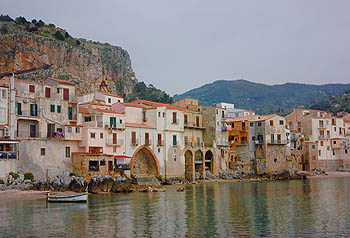 Eventually we did find a parking spot and a "funky" room on the top floor (lots of stairs) at a B&B in the old part of town for only €45 per night where we settled in for a two night stay. After a late seaside lunch we visited the Basilica Cattedrale, built in the 1100s in very plain Norman style except for its ornate altar. Cefalù reminded us very much of Chania in Crete with the old town stretched along the seaboard, pier jutting out into the water, and a somewhat Greek/Mediterranean feel. Dinner at LaBotte was a good experience; we liked the town.
Eventually we did find a parking spot and a "funky" room on the top floor (lots of stairs) at a B&B in the old part of town for only €45 per night where we settled in for a two night stay. After a late seaside lunch we visited the Basilica Cattedrale, built in the 1100s in very plain Norman style except for its ornate altar. Cefalù reminded us very much of Chania in Crete with the old town stretched along the seaboard, pier jutting out into the water, and a somewhat Greek/Mediterranean feel. Dinner at LaBotte was a good experience; we liked the town.
Cefalù is still an active fishing port as evidenced by the boats in the harbour and the net-menders on the shore. 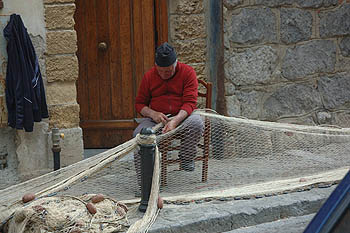
The next day, May Day, was a bank holiday so we decided to get away from the beach crowds and drive toward Castelbuono up in the Madonie Mountains. Our first stop was at The Sanctuary of Gibilmanna, a monastery/church dating to the Capuchian Friars of the 500s. The site is accredited with many miracles and was comfortably crowded with Sicilian pilgrims.
An antique painted cart in the attached museum caught George’s attention. In centuries past, these works of art were everywhere in Sicily but now few remain, reminders of another era - another, faintly remembered, way of rural life.
After lunch at Castelbuono, a lovely quiet hilltop town with, as its name suggests - its own castle, we headed back to Cefalù where we parked and made arrangements to go to Palermo the next day. Having discovered parking was free and that the car could remain safely there for as long as we wished, we left the car at the train station and walked back to our B&B.
Palermo
“the melting pot called Sicily seems to come together in one place - Palermo”
– John Keahey, Seeking Sicily
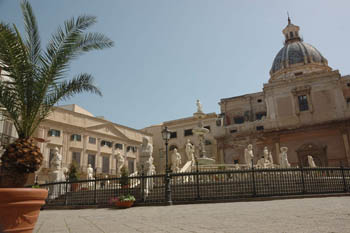 The next morning we checked out, left most of our luggage in the car, and caught an early train to Palermo, a 50 minute ride (€5.5) arriving mid-morning at the central station. After a long walk through the old parts of the city along Via Maqueda to Hotel Girabaldi, we checked in to our hotel -
The next morning we checked out, left most of our luggage in the car, and caught an early train to Palermo, a 50 minute ride (€5.5) arriving mid-morning at the central station. After a long walk through the old parts of the city along Via Maqueda to Hotel Girabaldi, we checked in to our hotel -  an excellent spot recommended in the Lonely Planet. After a light lunch at a wine bar behind the hotel, we walk through the streets of old Palermo; the centuries old marketplace of the Vucciria , the maze of twisted streets , most no wider than a footpath, that snaked between clusters of medieval buildings and then suddenly opening onto tiny squares piazzas, ending up at the Duomo. This Catholic Cathedral of Palermo, located in the city’s Capo quarter, is a magnificent and ancient cathedral with interesting Muslim touches from the Arab occupation of the 800’s (when it was converted into a great mosque – Gami.) It began to sprinkle lightly so, rather than get drenched, we took a tourist train back toward our hotel. The ride gave us another view of Palermo - a city where there is still much evidence of poverty and much reconstruction still waiting to be done but which does have some signs of vitality - and hopefulness. There is a sense that it is, perhaps, finally emerging from the many decades of Mafia oppression. There is even a modern monument to "the victims of the Mafia" - and the city airport is named after a judge murdered after "taking on some prominent Mafia bosses" in the 1990s.
an excellent spot recommended in the Lonely Planet. After a light lunch at a wine bar behind the hotel, we walk through the streets of old Palermo; the centuries old marketplace of the Vucciria , the maze of twisted streets , most no wider than a footpath, that snaked between clusters of medieval buildings and then suddenly opening onto tiny squares piazzas, ending up at the Duomo. This Catholic Cathedral of Palermo, located in the city’s Capo quarter, is a magnificent and ancient cathedral with interesting Muslim touches from the Arab occupation of the 800’s (when it was converted into a great mosque – Gami.) It began to sprinkle lightly so, rather than get drenched, we took a tourist train back toward our hotel. The ride gave us another view of Palermo - a city where there is still much evidence of poverty and much reconstruction still waiting to be done but which does have some signs of vitality - and hopefulness. There is a sense that it is, perhaps, finally emerging from the many decades of Mafia oppression. There is even a modern monument to "the victims of the Mafia" - and the city airport is named after a judge murdered after "taking on some prominent Mafia bosses" in the 1990s.
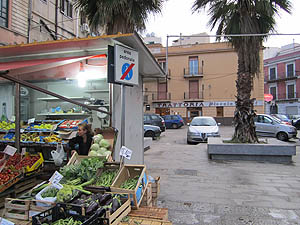
After getting back to the hotel (a bit damp), Tana dried off and rested while George went for a walk, in search of a restaurant. Entirely by chance, on a shabby side street, he came across Piccolo Napoli restaurant. It had been highly recommend in our Lonely Planet which had also said it was closed weeknights. It turned out to be open (it's open now every night, perhaps because guide books are recommending it) so George made a reservation for 8:30. It was a great restaurant - probably the best (most authentic) of the trip; George had an octopus and sea urchins antipasto and breaded squid and prawns while Tana enjoyed a antipasto buffet and pasta. We followed up with a delicious cake and multiple grappas.
Friday morning we took the train back to Cefalu, retrieved the car and meandered through central Sicily ending up in Piazza Armerina - a picturesque, highly recommended, hill top town. Much to our disappointment we discovered that this Friday was a festival day for this town - with the festival taking place outside town, leaving shops and restaurants there closed and the streets eerily quiet. The B&Bs in the town where either closed or unfriendly, expensive and awful. Getting frustrated and weary, we were about to leave (though reluctantly because it was late in the day and we had no other destination in mind.) We took a final drive through town and found Hotel Villa Romana (not listed in tourist guides but it should be) that was five-minute walk to the storico. We walked back into town and had dinner at a place that looked promising; the meal was not a good one - far too much food, too heavy and not much taste. Another bad Lonely Planet recommendation.
Modico
The next morning we drove for just two hours to Modico where we had booked a room at the Grana Barocca hotel, a 17th century noble palace furnished in an authentic baroque style, on the main drag. Modica, like the other towns in the Val di Noto, was badly damaged in the 1693 earthquake and largely rebuilt in Sicilian Baroque style.
 Our room turned out to be a fabulously ornate suite with 2 balconies overlooking the Main Street (Via Umberto I) from which we could watch the passagetta later in the evening. After lunch of battered anchovies and stuffed olives and a vegetarian pizza, we climbed the 400+ stairs to "Modica Alta" (Upper Modica), a warren of twisted lanes on the mount and explored the town, before enjoying supper at a great trattoria up a hidden laneway.
Our room turned out to be a fabulously ornate suite with 2 balconies overlooking the Main Street (Via Umberto I) from which we could watch the passagetta later in the evening. After lunch of battered anchovies and stuffed olives and a vegetarian pizza, we climbed the 400+ stairs to "Modica Alta" (Upper Modica), a warren of twisted lanes on the mount and explored the town, before enjoying supper at a great trattoria up a hidden laneway.
 It was with regret that we left after breakfast the next morning; we really liked the feel of this town. It was a hot day (as most of our days in Sicily had been). We stopped at the nearby Roman caves, Cava d'Ispica, a fascinating site featuring housing units (and "buildings") carved into the rocky formation prior to the Greek colonization. They were used until the end of the nineteenth century.
It was with regret that we left after breakfast the next morning; we really liked the feel of this town. It was a hot day (as most of our days in Sicily had been). We stopped at the nearby Roman caves, Cava d'Ispica, a fascinating site featuring housing units (and "buildings") carved into the rocky formation prior to the Greek colonization. They were used until the end of the nineteenth century.
Noto
“…modernity is not always good. One of the worst examples is on the approach to Noto, a city in southeastern Sisley. It snuggles against rolling hillsides, it's baroque character visible for miles in the foreground stand the modern hotel several stories high blocking the once picturesque view of a handful of stunning 17th and 18th century buildings when I asked the question why friends and Noto replied quote rules are bent; zoning laws, if they exist, are ignored; favors exchanged here and there. Nothing is done about it.”
Seeking Sicily
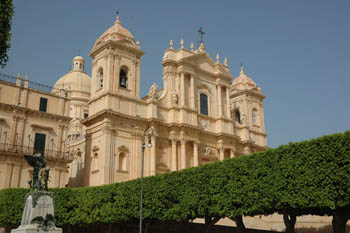 Then it was on to Noto where we encountered yet another traffic jam and a shortage of parking spaces for our monstrous vehicle. Noto is popular for its baroque buildings but in our mind there were just too many cars, too many people and not enough charm. We had booked a room in Palazzo Barack, an unusual centuries old private home now run as a B&B by the grandson of the earlier owners. Dinner was in an open-air patio restaurant (Trattoria Ducezio) in the backyard of a building, unassuming but good food and popular with the locals.
Then it was on to Noto where we encountered yet another traffic jam and a shortage of parking spaces for our monstrous vehicle. Noto is popular for its baroque buildings but in our mind there were just too many cars, too many people and not enough charm. We had booked a room in Palazzo Barack, an unusual centuries old private home now run as a B&B by the grandson of the earlier owners. Dinner was in an open-air patio restaurant (Trattoria Ducezio) in the backyard of a building, unassuming but good food and popular with the locals.
In the morning, after breakfast in an ornate room (in need of restoration) that had been the ballroom in this once fabulous home, the current owner gave us a private tour. The house was something of a family museum; his grandfather had been a doctor and his surgery (with all the medical instruments of his era still in place). The owner lives alone in the house (no wife or family now) sleeping in the bedroom where his grandparents had slept. He showed us that room too - pretty much as it had been except for a recently added flat screen TV.
Siracuse

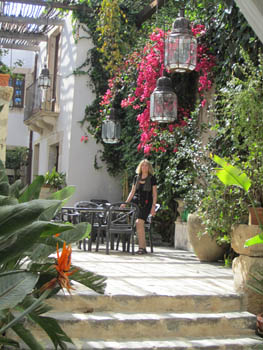 We said our good-byes to our host (who, with clearly little money and minimal staff, was working hard to turn this house/museum into a successful B&B so as to keep the old family home.) We headed back to Catania to get rid of the car (finally) and then took the bus to Syracuse where we took a cab to our hotel - Residence Alla Giudecca in the previously Jewish (Giudecca) area of ancient Ortigia. Once owned by Spanish Jews, who had converted to Christianity during the Inquisition, it was a lovely extensive property with its own ancient Mikveh, a bath used for the purpose of ritual immersion and purification in Judaism. We then prowled the side streets and toured the Duomo before having supper outdoors.
We said our good-byes to our host (who, with clearly little money and minimal staff, was working hard to turn this house/museum into a successful B&B so as to keep the old family home.) We headed back to Catania to get rid of the car (finally) and then took the bus to Syracuse where we took a cab to our hotel - Residence Alla Giudecca in the previously Jewish (Giudecca) area of ancient Ortigia. Once owned by Spanish Jews, who had converted to Christianity during the Inquisition, it was a lovely extensive property with its own ancient Mikveh, a bath used for the purpose of ritual immersion and purification in Judaism. We then prowled the side streets and toured the Duomo before having supper outdoors.
On Tuesday we crossed the bridge connecting Ortigia to Syracuse and walked to the Parco Archaeological. It was a very drab walk that made us glad we were not staying in Syracuse. The Park was refreshing and natural but we were not sure why we went there as it was very hot and there was very little to see. The ancient theatre, which is a main attraction, was being prepared for a live theatre event; the ancient stone seats were being covered over and transformed into modern looking, "comfortable" seating.
We headed back to Ortigia, had a light lunch in Piazza Duomo (where Tana tried to feed some stray cats who were scavaging there), did more exploring before our final Sicilian dinner.
We had booked a flight for the next day so as to give ourselves a couple of nights in RomeRome
Wednesday was a travel day; we taxied to the bus that took us back to Catania airport, flew to Rome and shuttled to our hotel, Sant Angelo in the Prati district of Rome near the Vatican.
 In Rome we felt at home. We were happy (and relieved) to finally be back in the city we both know and love. The people, the cars, the sirens – nothing bothered us. We walked and had a simple but great meal - the food, and the experience of eating, is always great in Rome.
In Rome we felt at home. We were happy (and relieved) to finally be back in the city we both know and love. The people, the cars, the sirens – nothing bothered us. We walked and had a simple but great meal - the food, and the experience of eating, is always great in Rome.
The next day (our last) we meandered up the Corso and relaxed with our books on a bench in the Borghese Gardens before pastries at the Café in the gardens. That evening we taxied to Trastevere and had a lovely, leisurely dinner at one of our favorite restaurants La Tana de Noantri. The waiter persuaded George to try Coratella, the heart, lungs, and liver of a young lamb, an extremely traditional holdover from the days when the majority of people were too poor to be able to afford richer cuts; it's a dish now found only in elegant restaurants.
Summing Up
The Sicily we saw (not the entire island but a large part of it) had its own spots of beauty, interesting moments and some good food but, honestly, it had nothing that would draw us back there. Rome, on the other hand (and Central and Northern Italy) does.
Was Sicily disappointing? In some ways NO. In some ways YES
Do we understand why? Not entirely. In part it was the large and unwieldy car and the hours spent in searching for parking; in part the heat that we had not anticipated. Also we had expected that Sicily would be different (more Mediterranean, influenced by previous occupying cultures of the Greeks and Turks) but it wasn’t.
Our search for hill towns, common in northern parts of Italy, lead us into the centre of Sicily and away from the coast which may have been our mistake. Perhaps on another occasion, and with a smaller car (or even travel by train) we will give Sicily another try.
Back to Travel Index
Back to HOME page
78 Mountain Ave, Hamilton, Ontario, Canada L8P4G2
All text and images are copyrighted. Any use is by permission only.
Site is under construction. Last update:
September 16, 2015
